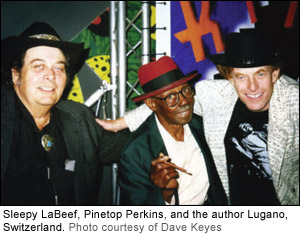 My career as a musician has covered many chapters. I’ve had my own band since I got out of college, been the bandleader for a daily national television program, conducted Broadway shows, done numerous sessions, released three CDs with a fourth on the way and worked as a sideman for dozens of artists. More than anything else, working as a sideman presents its own unique set of challenges, rewards, benefits and difficulties.
My career as a musician has covered many chapters. I’ve had my own band since I got out of college, been the bandleader for a daily national television program, conducted Broadway shows, done numerous sessions, released three CDs with a fourth on the way and worked as a sideman for dozens of artists. More than anything else, working as a sideman presents its own unique set of challenges, rewards, benefits and difficulties.
One of my earliest gigs as a sideman was with rockabilly artist Sleepy LaBeef. Our first appearance was a television show in Boston. Our “rehearsal” consisted of going to a Chinese restaurant and eating dinner. We did the TV show cold. Sleepy knows literally several thousand songs and can break into any one at any given time. I’d watch him like a hawk —he had no set list, nor any preconceived idea of what he was going to do onstage. My job was making him sound the best I could. I had plenty of opportunities to solo, shine and lead tunes, and after two nights of working with him, he asked me to open his set by singing two or three tunes.
That was my first experience leading a band. Sleepy really took me under his wing and gave me tapes of obscure Elvis, Carl Mann and Jerry Lee Lewis, saying in his deep Arkansas drawl “You ought to learn this stuff.” It’s material I still use to this day.
You learn a lot working with other people—seeing how they work a crowd, structure a set (even if it’s improvised) and learn new material. I’ve worked with dozens of blues artists in particular over the years—Eddy Clearwater, Tracy Nelson, Popa Chubby, James Carr, Ronnie and Wayne Baker Brooks, Carl Weathersby, Deborah Coleman—it’s fun to see how they go about making their magic.
One benefit of being a sideman is that working with more famous artists exposes your skills to more people than at your own local gigs. I worked with Bo Diddley throughout much of the ’90s. That job was a true sideman hit—playing in front of 25,000 people or more, meeting legends like James Brown and many others.
Over the last ten years, I had the privilege of working with the late great Odetta. Her needs involved helping her with the physical demands of being elderly on the road and eventually being wheelchair bound. Our onstage communication could be as simple as the way she tapped her feet to indicate that tempos were good or needed to be adjusted. If she turned to me between tunes with the all-knowing smile, I knew she was content—the monitor mix was good, etc. If she didn’t, I knew something was not just right. With her (and with gospel great Marie Knight whom I tour with presently) it’s just the two of us on stage—vocals and piano. In this situation, you ARE the band, and the word sideman is really a misnomer.
People really get to hear you play and that is what it’s all about.
I’m often asked, “Would you rather play with someone else as a sideman or do your own thing?” It really depends on the gig. I love doing my own thing, but whatever gets me to a wider audience and brings more joy to others through music works just fine for me.
—Dave Keyes
In addition to the artists mentioned above, Dave Keyes has supported Gladys Knight, Pam Tillis, Lou Rawls, Paul Butterfield, Chuck Berry, Buster Poindexter/David Johansen, Johnnie Johnson, Billy Vera, Taj Mahal, William Bell, Big Joe Turner, Ben E. King, Tanya Tucker, Darlene Love, Oliver Lake and Percy Sledge.



Be the first to comment!